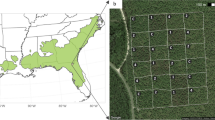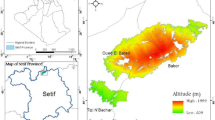Abstract
Savanna fire has many types: Savanna woody, Savanna vegetation, and grassland. In this paper, Savanna vegetation is studied, characterized by low trees and high grass. It grows in hot and seasonally dry conditions. The Savanna vegetation is described by relating to the environment and climate. Savanna vegetation is considered a metastable mixture of trees and grass and is advanced to explain stability. The Savanna vegetation is modeled with first-order linear differential equations having grass, trees, and sapling (young trees) as components. Furthermore, the model is evaluated numerically by integrating the global search technique Sine-Cosine algorithm and local search technique Interior point algorithm. Comprehensive numerical experiments are conducted to analyze numerical results. To validate solution of proposed technique, Runge-Kutta order four method isolution is taken as a reference solution. The solutions are compared graphically with the results of the reference technique. Performance indicators Mean Absolute Deviation, Root Mean Squared Error, and Error in Nash-Sutcliffe Efficiency are implemented to verify consistency, and multiple independent runs are drawn. Furthermore, the scheme is evaluated through convergence graphs as well.











Similar content being viewed by others
Abbreviations
- SCA:
-
Sine cosine algorithm
- IPA:
-
Interior point algorithm
- RK4:
-
Runge-Kutta methods order four
- ANN:
-
Artificial neural network
- SES:
-
Savanna ecosystem
- MAD:
-
Mean absolute deviation
- RMSE:
-
Root mean squared error
- ENSE:
-
Error in nash-sutcliffe efficiency
References
Accatino F, De Michele C, Vezzoli R, Donzelli D, Scholes RJ (2010) Tree-grass co-existence in savanna: interactions of rain and fire. J Theor Biol 267:235–242
Ahmad A, Sulaiman M, Alhindi A, Aljohani AJ (2020) Analysis of temperature profiles in longitudinal fin designs by a novel neuroevolutionary approach. IEEE Access 8:113285–113308
Atwell BJ, Kriedemann PE, Turnbull CG (1999) Plants in action: adaptation in nature, performance in cultivation. Macmillan Education AU, Australia
Banerjee S, Das D, John R (2022) Grassland-Woodland Transitions Over Decadal Timescales in the Terai-Duar Savanna and Grasslands of the Indian Subcontinent. Available at SSRN 4054431
Byrd RH, Hribar ME, Nocedal J (1999) An interior point algorithm for large-scale nonlinear programming. SIAM J Optim 9:877–900
Coetsee C, Wigley B, Sankaran M, Ratnam J, Augustine D (2022) Contrasting Effects of Grazing vs Browsing Herbivores Determine Changes in Soil Fertility in an East African Savanna. Ecosystems. https://doi.org/10.1007/s10021-022-00748-7
Drüke M (2022) Modeling biophysical feedbacks in the Earth system to investigate a fire-controlled hysteresis of tropical forests
Du HZF (2022) Suggestion to establish a nature reserve for protecting native savanna vegetation in hot dry valley of Jinshajiang. Yunnan. Biodiversity Science. p. 0
Evans RD, Ehleringer JR (1994) Water and nitrogen dynamics in an arid woodland. Oecologia 99:233–242
Fawad Khan M, Bonyah E, Alshammari FS, Ghufran SM, Sulaiman M (2022) Modelling and Analysis of Virotherapy of Cancer Using an Efficient Hybrid Soft Computing Procedure. Complexity. https://doi.org/10.1155/2022/9660746
February EC, Higgins SI (2010) The distribution of tree and grass roots in savannas in relation to soil nitrogen and water. South African J Bot 76:517–523
Frost P (1986) Responses of savannas to stress and disturbance: a proposal for a collaborative programme of research
Gardner TA (2006) Tree-grass coexistence in the Brazilian cerrado: demographic consequences of environmental instability. J Biogeogr 33:448–463
Guerrero-Sánchez Y, Umar M, Sabir Z, Guirao JL, Raja MAZ (2021) Solving a class of biological HIV infection model of latently infected cells using heuristic approach. Discrete Contin Dyn Syst-S 14:3611
Hamilton T, Archibald S, Woodborne S (2022) Historic changes in the fire-rainfall relationship at a woodland-savanna transition zone in southern Africa. African J Range Forage Sci 39:70–81
Hempson GP, February EC, Verboom GA (2007) Determinants of savanna vegetation structure: Insights from Colophospermum mopane. Aust Ecol 32:429–435
Higgins SI, Bond WJ, Trollope WS (2000) Fire, resprouting and variability: a recipe for grass-tree coexistence in savanna. J Ecol 88:213–229
Jeltsch F, Weber GE, Grimm V (2000) Ecological buffering mechanisms in savannas: a unifying theory of long-term tree-grass coexistence. Plant Ecol 150:161–171
Khan A, Sulaiman M, Alhakami H, Alhindi A (2020) Analysis of oscillatory behavior of heart by using a novel neuroevolutionary approach. IEEE Access 8:86674–86695
Khan NA, Sulaiman M, Tavera Romero CA, Alarfaj FK (2021) Theoretical Analysis on Absorption of Carbon Dioxide (CO2) into Solutions of Phenyl Glycidyl Ether (PGE) Using Nonlinear Autoregressive Exogenous Neural Networks. Molecules 26:6041
Khan MF, Sulaiman M, Romero CAT, Alkhathlan A (2021) Falkner-Skan Flow with Stream-Wise Pressure Gradient and Transfer of Mass over a Dynamic Wall. Entropy 23:1448
Khan MF, Sulaiman M, Tavera Romero CA, Alkhathlan A (2021) A Hybrid Metaheuristic Based on Neurocomputing for Analysis of Unipolar Electrohydrodynamic Pump Flow. Entropy 23:1513
Khan A, Stoy P, Joiner J, Baldocchi D, Verfaillie J, Chen M, Otkin J (2022) The diurnal dynamics of Gross Primary Productivity using observations from the Advanced Baseline Imager on the Geostationary Operational Environmental Satellite R Series at an oak savanna ecosystem. J Geophys Res Biogeosciences 127(3):e2021JG006701
Laio F, D’Odorico P, Ridolfi L (2006) An analytical model to relate the vertical root distribution to climate and soil properties. Geophys Res Lett. https://doi.org/10.1029/2006GL027331
Losey JE, Vaughan M (2006) The economic value of ecological services provided by insects. Bioscience 56:311–323
McLaren JR, Wilson SD, Peltzer DA (2004) Plant feedbacks increase the temporal heterogeneity of soil moisture. Oikos 107:199–205
Mirjalili S (2016) SCA: a sine cosine algorithm for solving optimization problems. Knowledge-Based Syst 96:120–133
Nieman WA, van Wilgen BW, Radloff FG, Tambling CJ, Leslie AJ (2021) Comparative use of adjoining burnt and unburnt habitats by large mammalian herbivores in a savanna-woodland ecosystem. Savanna-Woodland Fire Regimes Ecology Management and Conservation of African Protected Areas. Stellenbosch University, pp 304–351
Riginos C (2009) Grass competition suppresses savanna tree growth across multiple demographic stages. Ecology 90:335–340
Russell GG, Watson L, Koekemoer M, Smook L, Barker N, Anderson H, Dallwitz M (1990) others. Grasses of southern Africa. Number 58
Sagang LBT (2022) Monitoring Forest-Savanna Dynamics in the Guineo-Congolian Transition Area of the Centre Region of Cameroon. University of Yaoundey, pp 1-166
Sanou L, Savadogo P, Zida D, Thiombiano A (2022) Variation in soil seed bank and relationship with aboveground vegetation across microhabitats in a savanna-woodland of West Africa. Nordic J Bot. https://doi.org/10.1111/njb.03304
Scalon MC, Oliveras Menor I, Freitag R, Peixoto KS, Rifai SW, Marimon BS, Marimon BH, Malhi Y (2022) Contrasting strategies of nutrient demand and use between savanna and forest ecosystems in a Neotropical transition zone. Biogeosci Discuss 63:1–21
Scholes R, Archer S (1997) Interactions between woody plants and grasses in savannas. Annu Rev Ecol Syst 28:517–544
Sharma S, Singh G, Sharma M (2021) A Comprehensive Review and Analysis of Supervised-Learning and Soft Computing Techniques for Stress Diagnosis in Humans. Comput Biol Med 134:104450
Singh C (2022) Forest-savanna transitions Understanding adaptation and resilience of the tropical forest ecosystems using remote sensing. PhD thesis. Stockholm University
Staver AC, Levin SA (2012) Integrating theoretical climate and fire effects on savanna and forest systems. American Natur 180:211–224
Staver AC, Archibald S, Levin S (2011) Tree cover in sub-Saharan Africa: rainfall and fire constrain forest and savanna as alternative stable states. Ecology 92:1063–1072
Wang Z, Bao X, Wu T (2021) A parallel bioinspired algorithm for Chinese postman problem based on molecular computing. Comput Intell Neurosci. https://doi.org/10.1155/2021/8814947
Zhou Y, Singh J, Butnor JR, Coetsee C, Boucher PB, Case MF, Hockridge EG, Davies AB, Staver AC (2022) Limited increases in savanna carbon stocks over decades of fire suppression. Nature 603:1–5
Author information
Authors and Affiliations
Corresponding authors
Additional information
Publisher's Note
Springer Nature remains neutral with regard to jurisdictional claims in published maps and institutional affiliations.
Rights and permissions
About this article
Cite this article
Khan, M.F., Sulaiman, M. & Alshammari, F.S. A hybrid heuristic-driven technique to study the dynamics of savanna ecosystem. Stoch Environ Res Risk Assess 37, 1–25 (2023). https://doi.org/10.1007/s00477-022-02270-7
Accepted:
Published:
Issue Date:
DOI: https://doi.org/10.1007/s00477-022-02270-7




